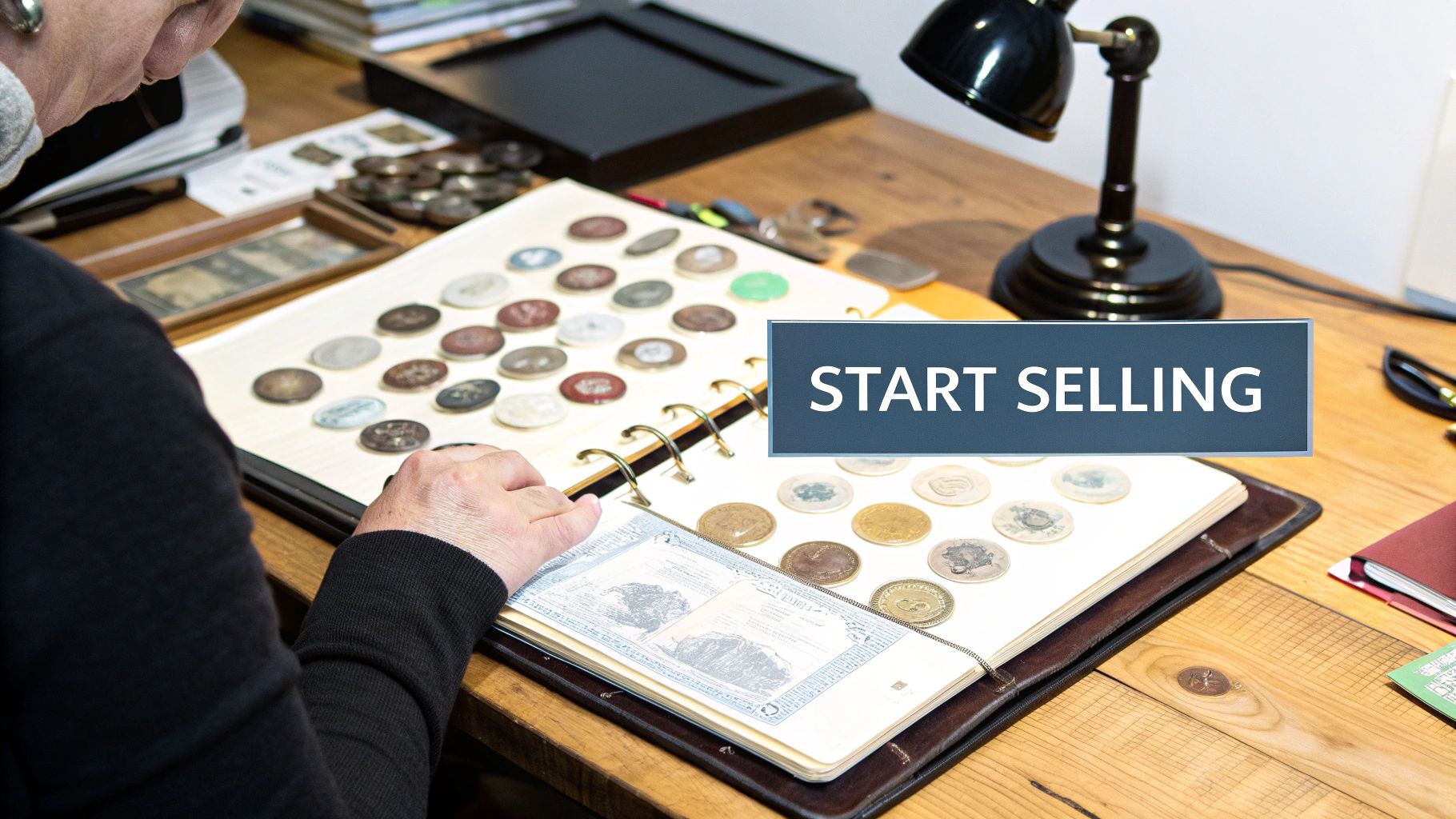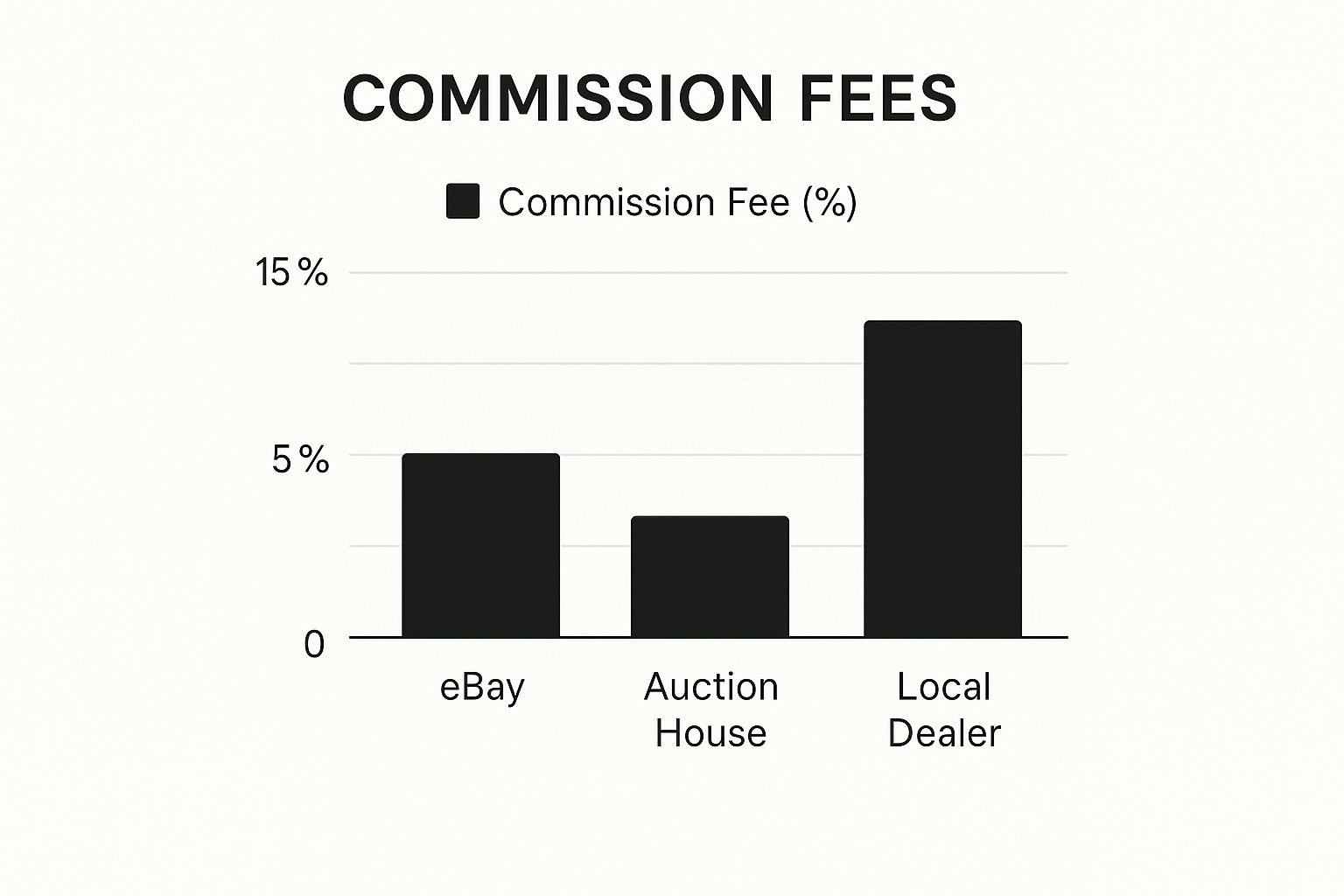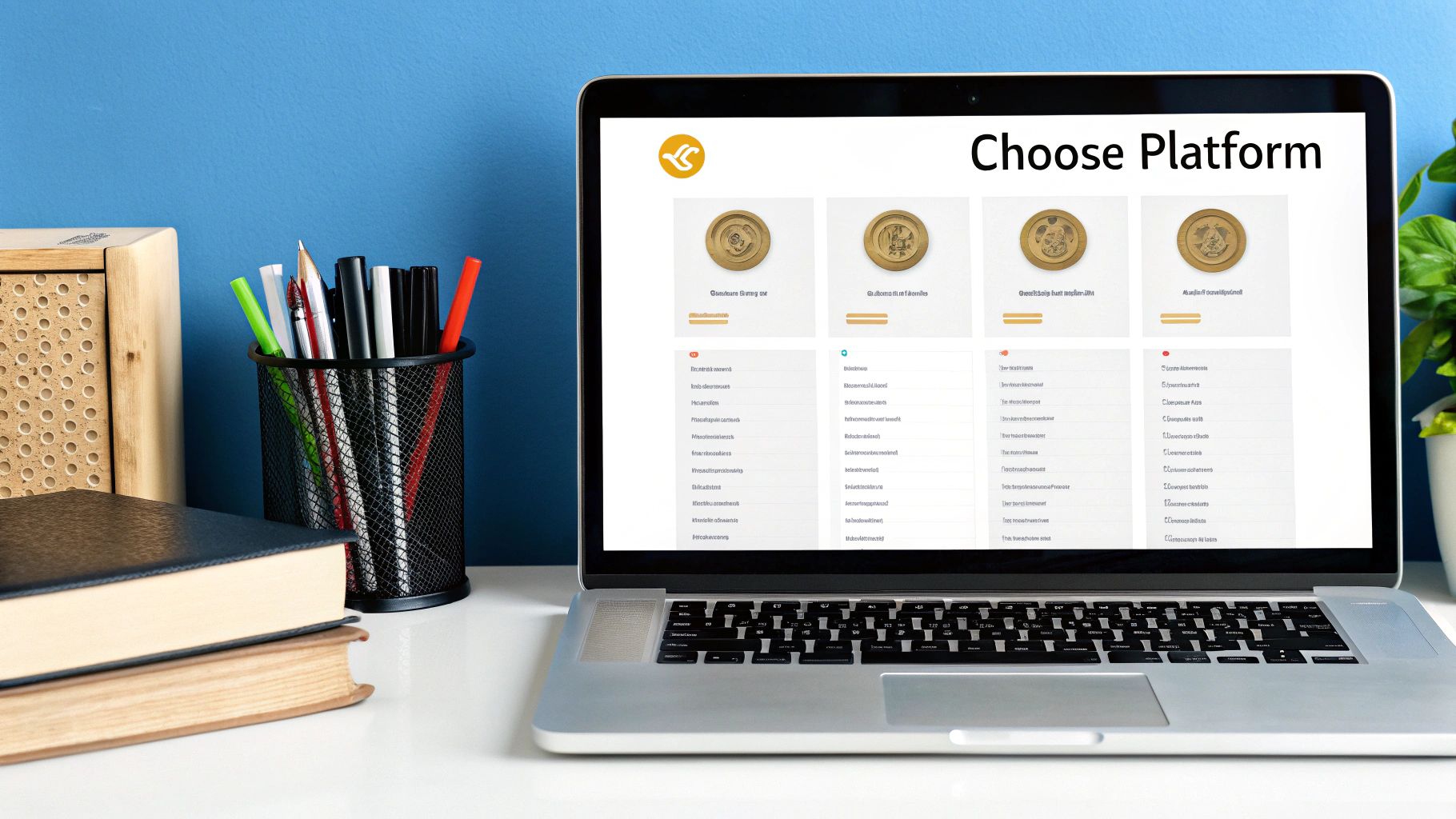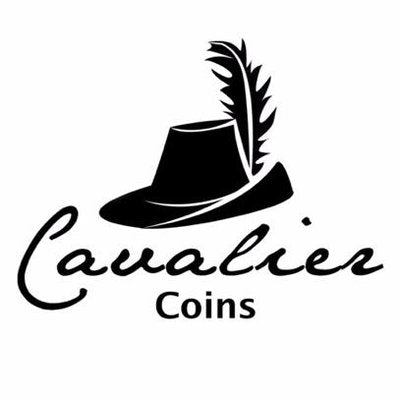Discovering What Your Collection Is Really Worth

Before you even consider selling your coin collection, it's vital to get a realistic picture of its value. Many people, whether they've been collecting for years or have just inherited a box of old coins, often have mistaken ideas about what their holdings are actually worth. The first, and most important, step is to methodically catalogue every single coin. This isn't just about jotting down dates and denominations; you need to note the condition, any mint marks, and other unique features.
This initial audit can be incredibly revealing. We once worked with a family who assumed their inherited collection was filled with common silver shillings. As they went through it, they found a rare 1933 penny tucked away—a coin of legendary scarcity and immense value. Without that careful inventory, it might have been overlooked entirely.
Researching Like a Dealer
With a detailed inventory in hand, you can start the real research. While looking at online auction sites can give you a rough feel for prices, professional dealers depend on more specialised resources. A professional price guide, like the annually published Spink catalogue for British coins, provides a much more stable benchmark than the ever-changing prices on marketplaces. Cross-referencing your key coins against these guides will give you a solid foundation.
You should also pay close attention to recent auction results from reputable auction houses. This shows you what serious collectors are actually willing to pay right now, which is a crucial part of learning how to value your old coins like an expert. This research helps you appreciate not just individual coin values but the wider market dynamics as well.
Understanding Market Nuances
It's a common error to think all old coins are valuable. Many Victorian pennies, for example, are quite common and hold only modest value unless they're in exceptional condition or belong to a rare variety. On the other hand, certain modern commemorative coins, like some of the Royal Mint’s limited-edition 50p pieces, can command surprisingly high prices due to intense collector demand.
To help you get a clearer picture, here’s a breakdown of common coin categories you might find in a UK collection and what to expect from them.
| Coin Type | Typical Value Range | Market Demand | Selling Difficulty |
|---|---|---|---|
| Common Modern Coins (post-1947) | Face value to £2 | Low (unless rare variety) | High (best sold in bulk) |
| Pre-1947 Silver Coins | Bullion value to 2x bullion | Moderate to High | Low to Moderate |
| Victorian Copper/Bronze | £1 - £100+ | Varies by condition/rarity | Moderate |
| Rare Date/Error Coins | £50 - £10,000+ | High (niche collectors) | Low (if authenticated) |
| Gold Sovereigns/Guineas | Bullion value to several times bullion | Consistently High | Low |
| Modern Commemorative 50p/£2 | Face value to £100+ | High (for specific designs) | Low to Moderate |
As you can see, the value is rarely just about age. A modern, limited-run coin can easily be worth more than a much older but more common one.
The global coin collection market was valued at USD 10.74 billion in 2024 and is projected to more than double by 2032. The UK is a significant part of this growth, with interest from both hobbyists and investors seeking tangible assets. This expanding market creates a great environment for sellers. For a deeper look at the numbers, you can explore the full report on the global coin market.
Your goal is to shift from thinking of it as "an old coin collection" to understanding your specific assets. Pinpoint your standout performers and separate them from the more standard coins. This knowledge is your most powerful tool as you prepare to sell.
Getting Appraisals That Actually Protect Your Interests
Once you’ve put together an inventory of your coins, the natural next step is to figure out what they’re worth. But not all valuations are the same, and picking the wrong path can be a costly mistake when it comes to selling coin collections. An inaccurate appraisal could undervalue your collection, costing you thousands, or overvalue it, which can damage your credibility with serious buyers who really know the market. The trick is to know when you need a formal, written appraisal versus when a chat with a knowledgeable dealer will do.
When to Seek a Formal Appraisal
A formal, written appraisal is typically required for insurance or estate settlements, but it’s also a powerful asset for very high-value collections. If you think you might have individual coins worth thousands of pounds, or a whole collection pushing into the five-figure range or more, getting a professional appraisal is essential. This document gives you an objective, defensible valuation that you can use to set a firm reserve price at auction or justify your asking price in a private sale.
Here’s a real-world example: A collector we know inherited a large set of gold sovereigns. He took them to a local 'cash for gold' shop and was given an offer based purely on their gold weight. Unconvinced, he sought a formal appraisal from a certified numismatist. The appraiser identified several rare dates and mint marks, ultimately valuing the collection at over three times the initial offer. That formal document was the proof he needed to secure a much better price from a specialist dealer.
Finding a Reputable Appraiser
It's crucial to find a qualified professional you can trust. A good starting point is to look for appraisers who are members of respected organisations like the British Numismatic Trade Association (BNTA). Before you commit to anyone, be sure to ask a few key questions:
- What are your credentials and do you have experience with my specific types of coins?
- How do you arrive at your valuation (e.g., recent auction results, price guides)?
- What is your fee structure? (A reputable appraiser will charge a flat or hourly rate, never a percentage of the collection’s value).
For many UK collectors, especially those focused on British coins, there are fantastic resources available to double-check an appraiser’s work. The market for British coins is extremely well-documented, with detailed guides providing pricing information that covers over two thousand years of coinage. These resources, which cover everything from ancient hammered coins to modern issues, give you a solid baseline of what dealers across Great Britain are paying. Using this data helps you confirm an appraisal and ensures the valuation is rooted in current market reality. You can learn more about the detailed valuation of British coins to better prepare yourself.
Ultimately, an appraisal is more than just a number on a piece of paper; it's a strategic tool. It shields you from lowball offers, gives potential buyers confidence, and provides the factual foundation you need to negotiate effectively and get the best possible return for your collection.
Avoiding Authentication Nightmares That Kill Sales

Nothing kills a promising coin sale quicker than a question about authenticity. In the world of selling coin collections, trust is paramount, and even a hint of doubt can make a serious buyer walk away. The counterfeit market has become alarmingly skilled, producing fakes that go far beyond the clumsy replicas of the past.
One collector learned this the hard way when he tried to sell what he thought was a rare Morgan silver dollar. An experienced buyer quickly spotted subtle inconsistencies in the lettering and the coin’s weight. It turned out to be a high-quality fake that had fooled him for years, and the sale collapsed on the spot. This is exactly why you need to verify your coins before you list them, getting ahead of any potential problems.
When Professional Authentication Is a Must
For common coins, a quick check against a reputable guide for weight and dimensions might be enough. But for high-value or frequently counterfeited coins, professional authentication isn’t just a good idea—it’s an investment that secures your sale. So, when should you seriously consider using a third-party grading and authentication service?
- For high-value pieces: Any coin you expect to sell for over £500 should be a candidate for professional certification. The cost of authentication is small compared to the value and buyer confidence it adds.
- For commonly faked coins: Historically important coins like Gold Sovereigns, rare-date pennies, or trade dollars are prime targets for forgers. Buyers will naturally be cautious, and a professional certificate is the best way to address their biggest concern.
- When you lack provenance: If you inherited a collection with no paperwork or history, authentication provides the official documentation you need to establish its legitimacy.
Building Trust with Buyers
Navigating authenticity is a major challenge in the UK's coin market, where concerns about fakes can affect trust and prices. The good news is that interest in numismatics remains strong, supported by a solid network of dealers and auction houses. Sellers who proactively manage authentication are in a great position to benefit. If you want to understand more about the market's direction, you can delve into the research on the UK coin collecting market outlook.
Presenting an authenticated coin completely changes the sales conversation. Instead of defending your coin's legitimacy, you can focus on discussing its condition and a fair market price. Having a certificate from a trusted service like the Numismatic Guaranty Company (NGC) or Professional Coin Grading Service (PCGS) before negotiations even start shows you’re a serious, transparent seller. It's the best way to turn a potential nightmare into a smooth, successful sale.
Choosing Your Selling Channel For Maximum Returns
Once your coins have been valued and authenticated, the next big decision is where to actually sell them. This choice is just as important as the appraisal itself. The right channel can significantly boost your final returns, while the wrong one can lead to real disappointment. When it comes to selling coin collections, there isn't a single best answer; the right path depends on your collection's value, how quickly you need the cash, and how much effort you're willing to put in.
Understanding the Main Platforms
Let's be honest: your local coin shop is often the quickest and simplest option. You can walk in, agree on a price, and leave with money in hand. This convenience, however, comes at a cost. The dealer has to make a profit when they resell, so their offer will naturally be below the coin’s retail value. It's a great choice for lower-value collections or when you simply need a fast, hassle-free sale.
For high-value individual coins or entire collections worth five figures or more, a major auction house is often your best bet. These houses have access to a global network of serious collectors who are ready to compete, which can sometimes lead to bidding wars and exceptional prices. But this route requires patience; you'll wait for the scheduled auction and then for the payment to be processed.
Then there's the do-it-yourself approach using online platforms. This method gives you the most control and the potential for the highest returns since you're cutting out the middleman. However, it also demands the most effort. You'll be responsible for everything: taking professional-quality photographs, writing compelling descriptions, handling customer enquiries, and arranging secure shipping. It's a trade-off between higher profit margins and a significant time commitment.
A Look at the Fees
To help you weigh your options, here’s a table comparing the different selling channels. It breaks down the typical fees, sale times, and effort required, so you can see at a glance which route might suit your situation best.
| Selling Channel | Average Fees | Time to Sale | Effort Level | Best For |
|---|---|---|---|---|
| Local Coin Dealer | 0% (but lower offer price) | Instant - 24 hours | Low | Fast cash, lower-value collections, convenience. |
| Major Auction House | 10% - 20% buyer's/seller's premium | 2 - 6 months | Medium | High-value, rare coins; collections worth £10,000+. |
| Online Marketplace (e.g., eBay) | 13% - 15% + listing fees | 1 - 4 weeks | High | Individual mid-range coins, bulk common coins. |
| Private Treaty Sale | Negotiable (often 0%) | Varies widely | Medium-High | Very specialised or high-value items for specific buyers. |
This table shows that while selling to a dealer is fast and fee-free, the lower offer price is an implicit cost. On the other hand, online marketplaces might seem accessible, but their fees can quickly add up, often exceeding those of a traditional auction house.
The infographic below offers a clear visual comparison of the commission fees you can expect from different platforms.

As you can see, the direct-to-dealer sale has the highest implicit cost through a lower offer, while auction houses can have surprisingly competitive commission rates compared to many online marketplaces.
Some experienced sellers even adopt a hybrid strategy. They might sell their best, highest-value pieces through an auction house to reach motivated collectors, consign mid-range coins to a trusted dealer, and then sell the remaining common coins in bulk lots online. This approach maximises the return for each part of the collection. For an even more detailed breakdown, check out our guide on the top options for where to sell old coins, which offers deeper insights into each channel. Choosing wisely here is a crucial step toward a successful and profitable sale.
Presenting Your Collection Like A Seasoned Professional

First impressions count for everything when you're selling coin collections. The moment a potential buyer lays eyes on your listing, they are making a snap judgement. Excellent presentation can make them feel confident and ready to place a bid, whereas poor presentation could make them scroll right past, costing you a significant sale. Even the most valuable coins can fail to meet their true market price if they are photographed poorly or described without care.
The aim is to show your coins in their best possible light while being completely honest about their condition. Experienced collectors have a sharp eye and can spot deceptive photography from a mile away. It’s far better to present any condition issues, like scratches or marks, transparently than to try and hide them. This approach builds the trust that is absolutely essential for a successful transaction.
Crafting Listings That Attract Serious Buyers
Think of your listing as your sales pitch. It needs to attract the right people—serious collectors—while filtering out those who are just browsing or hoping to make a lowball offer. It often helps to tell a story. Was this a collection built over a lifetime? Does it centre on a specific theme, like Victorian-era pennies or coins from a particular monarch’s reign? Adding this personal touch can make your collection far more compelling.
When you're putting your sale together, keep these practical tips in mind:
- Group Strategically: Rather than listing hundreds of individual common coins, group them into logical, appealing lots. For instance, a complete date run of shillings or a "world silver" bag can be very attractive to bulk buyers.
- Write with Precision: Use clear, accurate language. Always state the coin’s date, denomination, mint mark, and a fair assessment of its grade. If a coin has a scratch or environmental damage, mention it. Honesty upfront prevents disputes later on.
- Tell the Story: For your standout pieces, add a sentence or two about their historical context or what makes them rare. This personal detail connects with a collector's passion.
Photography That Sells
Your photographs are, without a doubt, the most important part of your listing. Poor-quality, blurry photos scream "amateur" and can make potential buyers suspicious. You don't need a professional studio setup, but you absolutely must get the basics right. Use a plain, neutral background—a piece of black or white felt works wonders—and make sure you have good, diffused lighting to avoid glare.
Take sharp, high-resolution photos of both the obverse (front) and reverse (back) of each key coin. Don't forget a clear shot of the edge, as this is a crucial detail for many collectors.
For anyone looking to improve their collection, whether buying or selling, mastering these small details is key. If you're looking for more great advice, you might be interested in mastering the craft with our top tips for collecting coins. Ultimately, presenting your collection professionally shows respect for both the coins and the potential buyers, setting the stage for a smooth and profitable sale.
Mastering Negotiations That Protect Your Bottom Line
The final moments of a sale can be the difference between hitting your target price and leaving a hefty sum of money on the table. When it comes to selling coin collections, successful negotiation isn't about aggressive haggling; it's about confident, well-informed discussion. This all begins with knowing your ‘walk-away’ price before any conversation even starts. This shouldn't be a random figure but a firm floor based on your research and appraisals.
Handling Offers and Building Rapport
When an offer comes in, especially a low one, the worst thing you can do is react emotionally. A lowball offer isn't necessarily an insult; it's often just a buyer's opening move. Instead of getting defensive, a calm and factual response works wonders. Try something like, "Thank you for the offer, but that's quite a bit lower than the market value suggests. My research and appraisal place it closer to X." This keeps the conversation going respectfully and shifts the focus back to the facts.
Building genuine rapport can also completely change the dynamic of a negotiation. We know a seller who was parting with his grandfather’s collection of pre-decimal silver. Instead of focusing solely on the price, he shared a short story about how his grandfather had gathered the coins over the years. The buyer, a passionate collector himself, really connected with that personal history. This didn't mean he overpaid, but it established a level of trust that made finalising the price a smooth and positive experience for both of them.
Structuring a Successful Deal
A great deal is one that protects both you and the buyer. Once you've settled on a price, the transaction details become just as crucial. Here’s what you need to finalise:
- Payment Method: For private sales, a bank transfer is usually the most secure route. Always wait until the funds have fully cleared in your account before you hand over or post the coins. Never agree to promises of future payment.
- Shipping and Insurance: Clearly establish who is responsible for the shipping costs. For any valuable collection, using a tracked and fully insured service like Royal Mail Special Delivery is essential. The extra cost is a small price to pay for complete peace of mind.
- Documentation: Prepare a simple sales receipt for both you and the buyer to sign. It should include a list of the items sold, the final agreed-upon price, the date, and the names of both parties. This straightforward document can prevent any future confusion.
Remember the story of the seller who turned one interested person into three competing offers? He achieved this by being transparent with each potential buyer, letting them know there was other serious interest. This created a natural sense of urgency and reinforced the collection's value, ultimately driving the final price up by nearly 20% without using any high-pressure tactics. Managing interest smartly is a key part of closing the deal successfully.
Your Roadmap To Selling Success
Turning your research into a successful sale comes down to having a clear, organised plan. Think of this as your personal checklist for success when selling coin collections, bringing together everything we've discussed into a few key actions. Whether you’ve inherited a small set or spent years building a large, curated collection, these steps will guide you towards a great result.
Your Essential Preparation Checklist
Before you even think about approaching a buyer, it’s vital to get your ducks in a row. Experienced sellers know that laying this groundwork is the key to a smooth and profitable transaction. Don’t be tempted to skip these steps.
- Inventory and Research: First, catalogue every single coin. Make a note of its date, mint mark, and, most importantly, its condition. Then, dive into some research to find realistic market values. Rely on professional price guides rather than just looking at what similar items are listed for on online marketplaces, as those prices can be misleading.
- Authentication and Appraisal: If you have any high-value coins or pieces that are commonly faked, it's a wise investment to get them professionally authenticated. For any collection you expect to fetch a significant price, securing a formal appraisal from a trusted expert is non-negotiable.
- Professional Presentation: How you present your collection matters. Take clear, well-lit photos of your coins against a plain, neutral background. When you write your descriptions, be honest and detailed. This transparency builds trust with potential buyers from the outset.
Monitoring Your Progress
A successful sale isn’t just measured by the final price. Keeping an eye on these indicators will tell you if you're on the right track throughout the process.
- Response Quality: Pay attention to the kind of interest you're getting. Are you attracting serious enquiries from knowledgeable collectors, or are you mostly dealing with lowball offers and time-wasters?
- Negotiation Confidence: When you enter discussions, do you feel in control? Armed with the facts and figures from your research and appraisal, you should feel confident in your position, not pressured into a quick sale.
Following this simple roadmap provides a reliable framework for getting the best return on your collection while giving you peace of mind.
At Cavalier Coins Ltd, we're passionate about helping collectors at every stage of their journey. Explore our extensive selection of world coins and banknotes or contact us for advice on your collection today.

